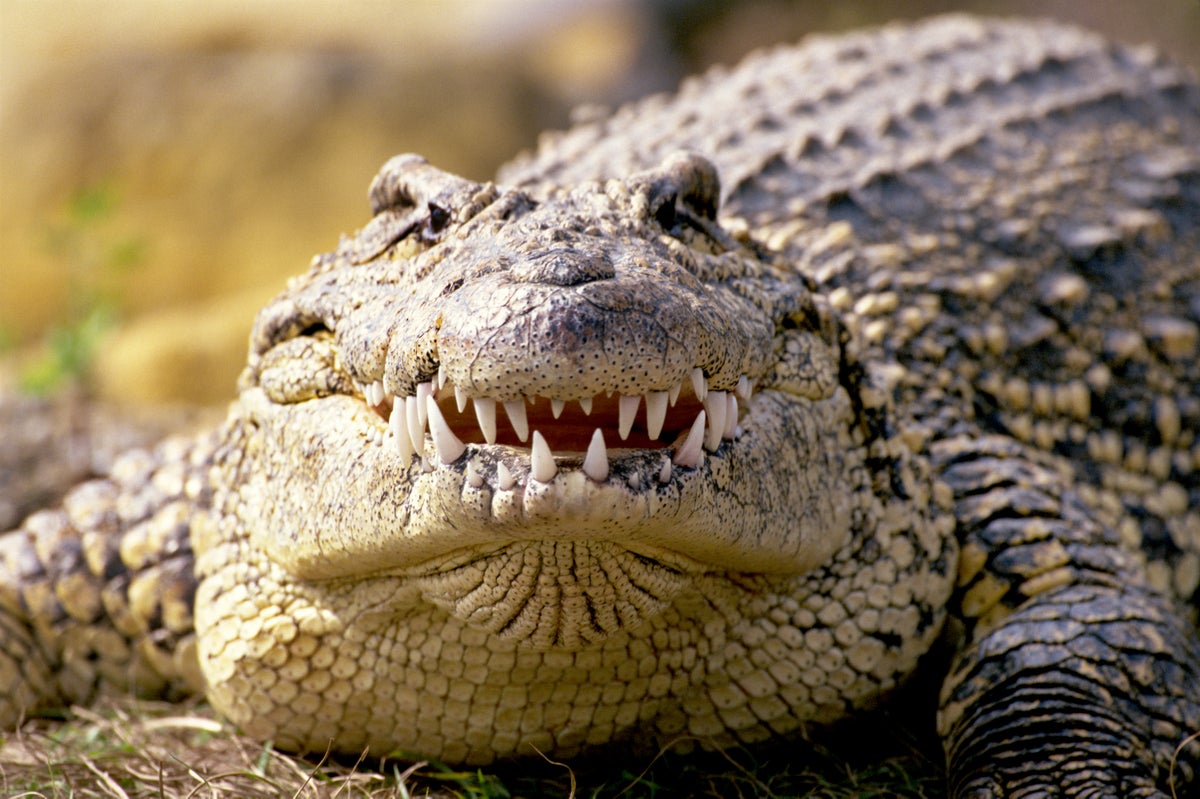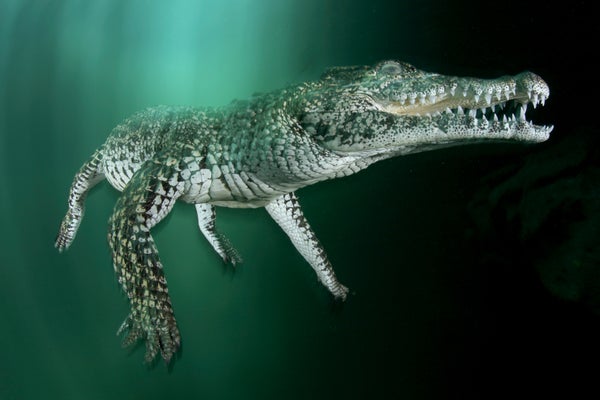The critically endangered Cuban crocodile (Crocodylus rhombifer) has many peculiar qualities, but perhaps the most intriguing one is its curiosity. For biologists conducting fieldwork in Zapata Swamp, Cuba’s largest wetland and the only place in the world where the species is found, this is a notable trait. The crocs will investigate a campsite if nothing prevents them. Protective netting is deployed to keep them out, although not always successfully. “The animal comes inside the camp looking for a warm place to sleep beneath”—referring to human bodies in hammocks, says Etiam Pérez, a Cuban crocodile researcher and manager of the Zapata Swamp Captive Breeding Farm.
Pérez is speaking to Scientific American at the farm, beside an open-air pen that holds hundreds of young, brilliant, black-and-yellow Cuban crocodiles under the fierce Caribbean sun. The tropical facility claims more than 4,000 specimens of what Pérez calls “the most beautiful crocodile in the world.” Like most Cuban operations it is government-owned, and was founded 57 years ago by Fidel Castro himself. A large black-and-white photograph of Castro hangs on a wall of the facility, complete with a lengthy quotation from the late autocrat praising Cuban crocodile conservation. The animal, Pérez says, holds a kind of political and symbolic weight in Cuba, especially in in the south-central Matanzas Province, where Zapata Swamp is located.
But the crocodile’s vaunted status has not prevented its decline. Overhunting in the 19th and 20th centuries coupled with deforestation from increased development in modern times has reduced its population to historic lows. Scientists estimate only around 3,000 wild crocs are left, although even that number comes largely from guesswork. Now scientists are scratching their heads over another potential threat to these reptiles: interbreeding with American crocodiles (Crocodylus acutus).
On supporting science journalism
If you're enjoying this article, consider supporting our award-winning journalism by subscribing. By purchasing a subscription you are helping to ensure the future of impactful stories about the discoveries and ideas shaping our world today.
Is Hybridization to Blame?
The most widely distributed crocodilian species in the Americas, C. acutus, is native to Cuba (as well as the U.S.) and, unlike C. rhombifer, flourishing across the country. Scientists say the two species are morphologically, ecologically and behaviorally distinct from each other. Increased hybridization of the two poses an existential risk to the much less common Cuban species via a gradual erosion of its genetic identity. For conservation-minded scientists, this is worrying indeed. “The concern is that widespread hybridization might eliminate the unique Cuban crocodile through [such] genetic swamping,” says George Amato, a conservation genomics biologist at the American Museum of Natural History.

Cuban crocodile.
Credit: Getty Images
Yoamel Milián-García, a biologist at the University of Havana, first published data on the hybridization epidemic in 2015. He analyzed scale clippings of 227 wild crocodiles and 137 farm-raised ones, finding that 49.1 percent of the wild specimens were hybrids and 16.1 percent of captive ones possessed mixed genes. “The degree of hybridization that we’re seeing seems much higher than we would have predicted or imagined,” Amato says. “Some people think it’s the biggest threat” to these animals, he adds.
But nobody knows for sure. Hybridization could be a frightening species eraser. It could also be a normal historical process, says Amato, who has collaborated with Cuban biologists, including Milián-García and Pérez, on crocodile research there since the 1990s. Scientists simply do not have enough evolutionary or biological data yet to decide which interpretation is the right one.
Conservation Challenges
The reason for this is partly logistical: The 300-square-kilometer area of Zapata where Cuban crocodiles reside is famously difficult to access and there has not been sufficient survey work to gain a complete picture of what is happening there; for Cuban crocodile research, foreign assistance is critical. Local scientists, in part due to the U.S. embargo against Cuba, possess scant resources. Milián-García is only able to conduct his work on hybridization because he uses advanced technologies available in Canadian and U.S. labs.
Even the Zapata breeding farm must supplement its meager government income with other means. Ticket sales from tourists are a major funding source. Visitors, mostly Cubans, tour the facility and for a few Cuban pesos (about 50 cents) they can feed the reptiles raw meat with a stick. The farm also slaughters a small number of its crocodiles for their meat, which is sold to designated restaurants; it is the only organization in the country legally permitted to do so. Although perhaps strange-sounding to U.S. environmentalists, Pérez stresses that such business brings in good money for the breeding farm. Alongside breeding-and-release, there is also an ongoing public outreach program that aims to reduce poaching and crocodile consumption through informational posters hung in schools and restaurants. The farm also employs six former poachers as an alternative employment to illegal hunting.
The facility, which takes pains to produce only non-hybridized crocodiles, acts as a stopgap in the fight against extinction—but genetic mixing complicates conservation planning. Should genetic purity be the ultimate goal? Or should hybridization be allowed to run its course, possibly resulting in a species better adapted to a changing environment? Complicating things further is recent evidence suggesting American crocodiles in Cuba are related more closely to the Cuban croc than to their own counterparts in the continental U.S., a genetic connection Milián-García calls a “sister relationship.”
Meanwhile American crocodiles, which abound across Cuba, are not threatened by hybridization, Amato says. “Where hybridization is increased, it’s not that we’re seeing Cuban genes going to American crocs—it’s mostly that it’s American genes going into [animals in] the one small area in Zapata where the Cuban crocodiles live,” he says.
The Future of Cuban Crocs
There is a plan, however, to maintain a genetically pure population of Cuban crocodiles by breeding the species and then releasing them into the wild. The first release of 100 crocs happened last year. The latest one, conducted in June in conjunction with the New York City–based Wildlife Conservation Society, involved 10 animals. All the genetically pure Cuban crocodiles were let go in areas of the Zapata Swamp that are free of American crocodiles—the latter mostly stick to brackish waters whereas Cubans need freshwater. Another such release is currently in the works, Pérez says.
Amato and Milián-García have also begun a survey of Cuba as a whole that involves sequencing the genomes of various crocodile species, hoping to get a better understanding of the genetic relationships among them. This, in turn, will inform future conservation planning. “We’ll get a better sense of, with animals that we’re calling hybrids: Does that hybridization look like a phenomenon that happened thousands of years ago or something that’s very recent?” Amato says. In conjunction with these efforts he and his colleagues will also be analyzing ancient crocodile remains.
As Pérez puts it back at the farm, surrounded by sagging palms and sunbathing crocs, “If you understand the past, you can predict the future.”
